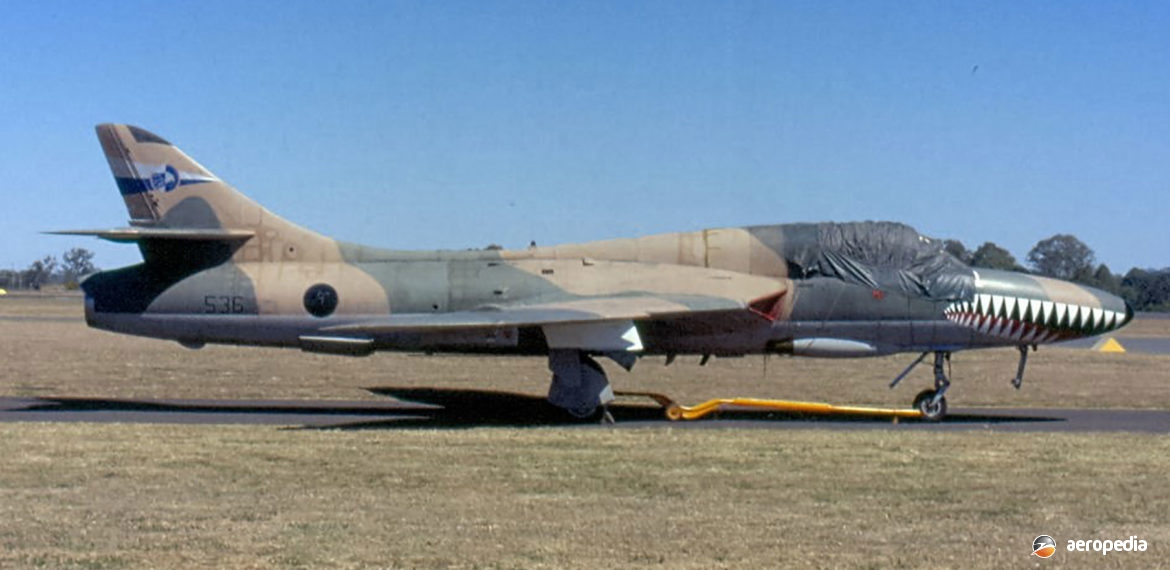Photograph:
Hawker Hunter T.75S VH-XHH 536 (c/n HABL003118) at Archerfield, QLD in September 2003 (David C Eyre)
Country of origin:
United Kingdom
Description:
Two-seat advance trainer
Power Plant:
(T.7)
One 10,150 lbst Rolls Royce Avon 207 turbojet
Specifications:
- Wingspan: 10.26 m (33 ft 8 in)
- Length: 14.91 m (48 ft 10½ in)
- Height: 4.26 m (13 ft 2 in)
- Wing area: 23.97² m (258 sq ft)
- Max speed at 11,000 m (36,000 ft): 1,149 km/h (714 mph)
- Rate of climb at sea level: 4,570 m/min (15,000 ft/min)
- Service ceiling: 16,760 m (55,000 ft)
- Take-off distance over 15 m (50 ft) obstacle: 685 m (2,750 ft)
- Landing distance over 15 m (50 ft) obstacle: 777 m (2,550 ft)
- Range with two 1,040 litre (230 Imp gal) and two 455 litre (100 Imp gal) fuel tanks
- [total of 4,782 litres -1,052 Imp gals): 2,965 km (1,840 miles)
- Empty weight: 5,965 kg (13,150 lb)
- Max military load: 3,220 kg (7,100 lb)
- Loaded weight: 10,660 kg (23,500 lb)
Armament:
One 30 mm Aden cannon under nose; provision for up to two 454 kg (1,000 lb) bombs; practice bombs; clusters of six 76.2 mm (3 in) rockets; up to 37 folding fin rockets; two Sidewinder or de Havilland Firestreak air-to-air missiles under each wing
History:
In 1954 Hawker chose to develop a two-seat variant of the Hunter, the prototype (XJ615) flying for the first time on 8 June 1955, a production order being placed for 55 aircraft with the designation Hunter T.7. The first production aircraft flew on 11 October 1957 and deliveries soon began to No 229 Operational Conversion Unit (OCU) at Chivenor in Devon. Most Royal Air Forcd (RAF) front-line Fighter Command units received at least one T.7 for proficiency training, and for use as squadron hacks. Others were supplied to RAF fighter stations. Forty-five T.7s were built, and in addition six F.4s were converted to T.7 configuration. A number served at Lossiemouth in Scotland where they were used for training by Blackburn Buccaneer squadrons.
The Royal Navy (RN) sought a trainer for use in training crews for the de Havilland Sea Vixen and Supermarine Scimitar units and to this end ten Hunters were diverted from the production line and completed as the Hunter T.8, these being fitted with a tail hook, not for carrier operations but for field carrier landing training. First delivery was XL581 to No 736 Squadron in July 1958, followed by No 764 Squadron. Three went to Royal Naval Air Station (RNAS) at Yeovilton in Somerset initially, but eventually all T.8s were based there, being used to train Hawker Harrier crews.
The trainer variant was popular with other air arms. The T.53 was supplied to Denmark; the T.62 to Peru; the Dutch Air Force received 20; the T.66 to India; the T.66B to Jordan; the T.66C to The Lebanon; the T.68 to Switzerland; the T.67 to Kuwait; Saudi Arabia received the T.70 and, following the British withdrawal from Singapore, the new Republic of Singapore Air Force (RSAF) received an initial batch of four T.75s, followed by five T.75As, these being used as proficiency trainers with single-seat equipped Hunter squadrons. Further deliveries were made: the T.72 to Chile, the T.69 to Iraq, the T.77 to Abu Dhabi, the T.79 to Qatar, and the T.81 to Kenya, one of these later joining others in Zimbabwe.
Following the withdrawal of the Hunter from Singapore service the surviving fleet was imported to Australia and a few were allotted civil registrations. There were six two-seat Hunters in this batch, these being serials 500, 516, 528, 532, 536 and 540. Those for which registrations were allotted have included: VH-HMS (c/n HABL-003071), a T.7; VH-XHH (c/n HABL-003118), a T.75A; and VH-RHO (c/n HABL-003125), a T.75S. In 1997 Skywise Aviation in Tasmania took delivery of an ex-Royal Navy T.8C (XF310) from RNAS Culdrose in Cornwall. This aircraft had been delivered as an F.4 to the RAF in late 1955 and in 1959 was converted to T.8 standard with an arrester hook.
One ex-Singapore Air Force T.75S serial 516 (c/n 500) was shipped to New Zealand. It was originally delivered to the Royal Navy as a T.7. It was converted to T.75 configuration, being delivered to the RSAF as 516 in the 1970s. This aircraft has been placed on display at the Classic Fighters Museum at Tauranga.

